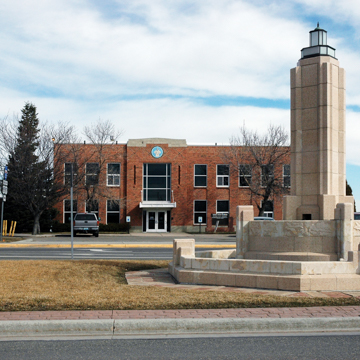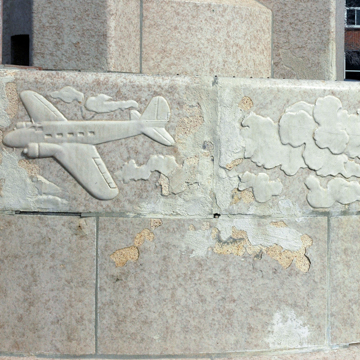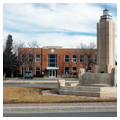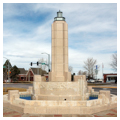You are here
Cheyenne Airport Old Terminal Building and Fountain
Comparing the Cheyenne Regional Airport with major U.S. airports today, it is difficult to imagine that in the first few decades of the twentieth century, Cheyenne was a major transcontinental air travel hub. Today, the original terminal building and fountain remain to tell this story.
The U.S. Post Office initiated coast-to-coast air mail service in 1920, using army pilots and airplanes. These early flights followed the line of the Union Pacific transcontinental railroad through southern Wyoming, which offered the best aerial route through the Rocky Mountains at that time when planes could not fly above 10,000 feet. Cheyenne was chosen as the division point between Omaha, Nebraska, and Salt Lake City, Utah, one of fifteen such division points nationwide. In 1921, pilots attempted the first nighttime flights, initially navigating by bonfires set by farmers along the way and later following a series of rotating light beacons, some of which can still be found in southern Wyoming.
In 1925, Congress allowed commercial airlines to take over the airmail service and whenever possible, these planes began carrying passengers. The contract for the Chicago-to-San Francisco route was awarded to Boeing Air Transport Company, which became United Aircraft and Transport Company (predecessor to United Airlines) in 1929. United Aircraft chose Cheyenne as the location of its main overhaul facility for maintaining and repairing planes. With the introduction of the fourteen-passenger B-80 in 1929, United became the first airline to employ stewardesses to provide service to airline passengers, and air travel became established as an acceptable transportation alternative. That same year, the City of Cheyenne erected a terminal building to accommodate the growing number of air passengers and with the hope that Cheyenne would remain dominant in regional air travel.
The two-story, brick Cheyenne Boeing-United Airline Terminal was designed by the Austin Company of Seattle and Portland, Oregon. The simple rectangular building gets its architectural interest from the rhythm of vertically aligned first- and second-story windows with inset spandrels separated by brick piers, and by decorative brickwork in cross and basketweave patterns at the cornice line. The defining feature of the facade is the off-center pavilion, which has a large window above canopied French doors and is topped by a stepped concrete parapet. In the space below the parapet is a circular terra-cotta disk on which a Boeing insignia was once painted. Inside, the west side of the building contained a waiting room that resembled a long living room, with couches, chairs, and floor lamps in comfortable groupings around a fireplace. Passengers embarked and deplaned through a separate entrance on the east elevation, where planes pulled up on a paved apron. The second story was used for offices.
The other important architectural feature from the Cheyenne airport’s heyday is the Art Deco terra-cotta fountain located in the median of Eighth Avenue, south of the terminal building. The fountain was commissioned by the city of Cheyenne in 1935 as part of an airport beautification project, and was designed, fabricated, and constructed by the Denver Terra Cotta Company. Located prominently in front of the original passenger terminal, the fountain created a formal entrance to the city's airport. Built entirely of terra-cotta, the fountain features an 18-foot-tall pylon, distinguished by its classic Art Deco lines, that rises from two concentric pools accented with ziggurat features. The upper pool is decorated with bas relief airplanes flying through the clouds. Topping the tower is a light that resembles the navigational light beacons found at airports of the period. Illuminated by submerged colored lights similar to those used at the Century of Progress International Exposition in Chicago the year before, water shot upward from jets in the upper pool and cascaded through a terra-cotta scupper into the lower reflecting pool.
The Cheyenne airport continued to grow with additional carriers and maintenance operations up to and through World War II, when it served as a modification center for bombers. With the development of the four-engine DC-4, which could fly at an altitude of 18,000 feet, Cheyenne prominence as an air travel and maintenance hub began a slow decline. After the war, all airport operations of national significance gradually moved from Cheyenne to more populous centers like Denver, Colorado, which replaced Cheyenne as the major airline center of the Rocky Mountain Region. When Cheyenne built a new terminal in 1959–1960, the 1929 terminal was converted for use by the airport administration. Though the Airport Fountain was a prominent local landmark in the 1940s and 1950s, its significance diminished when the new terminal was completed. The new terminal, designed by Cheyenne architect Robert William Postin, recalls the TWA Terminal Building in New York, with its sweeping roof resembling wings in flight and canted glass walls.
References
Fraser, Clayton, B., “Cheyenne Airfield, Fountain (HAER WY-83-B),” Historic American Engineering Record, Denver, CO 2009.
Plambeck, Maurice, “Boeing/United Airlines Terminal Building, Hangar and Fountain,” Laramie County, Wyoming. National Register of Historic Places Inventory – Registration Form, 1983. National Park Service, U.S. Department of the Interior, Washington, DC.
Rosenberg, Robert G., “Cheyenne Airport Property Building and Structures Inventory,” Wyoming Historic Architecture Inventory Form, Cheyenne, WY, 1997.
Rosenberg, Robert G., “Cheyenne Airfield,” Historic American Engineering Record, Denver, CO, 1998.
Writing Credits
If SAH Archipedia has been useful to you, please consider supporting it.
SAH Archipedia tells the story of the United States through its buildings, landscapes, and cities. This freely available resource empowers the public with authoritative knowledge that deepens their understanding and appreciation of the built environment. But the Society of Architectural Historians, which created SAH Archipedia with University of Virginia Press, needs your support to maintain the high-caliber research, writing, photography, cartography, editing, design, and programming that make SAH Archipedia a trusted online resource available to all who value the history of place, heritage tourism, and learning.























